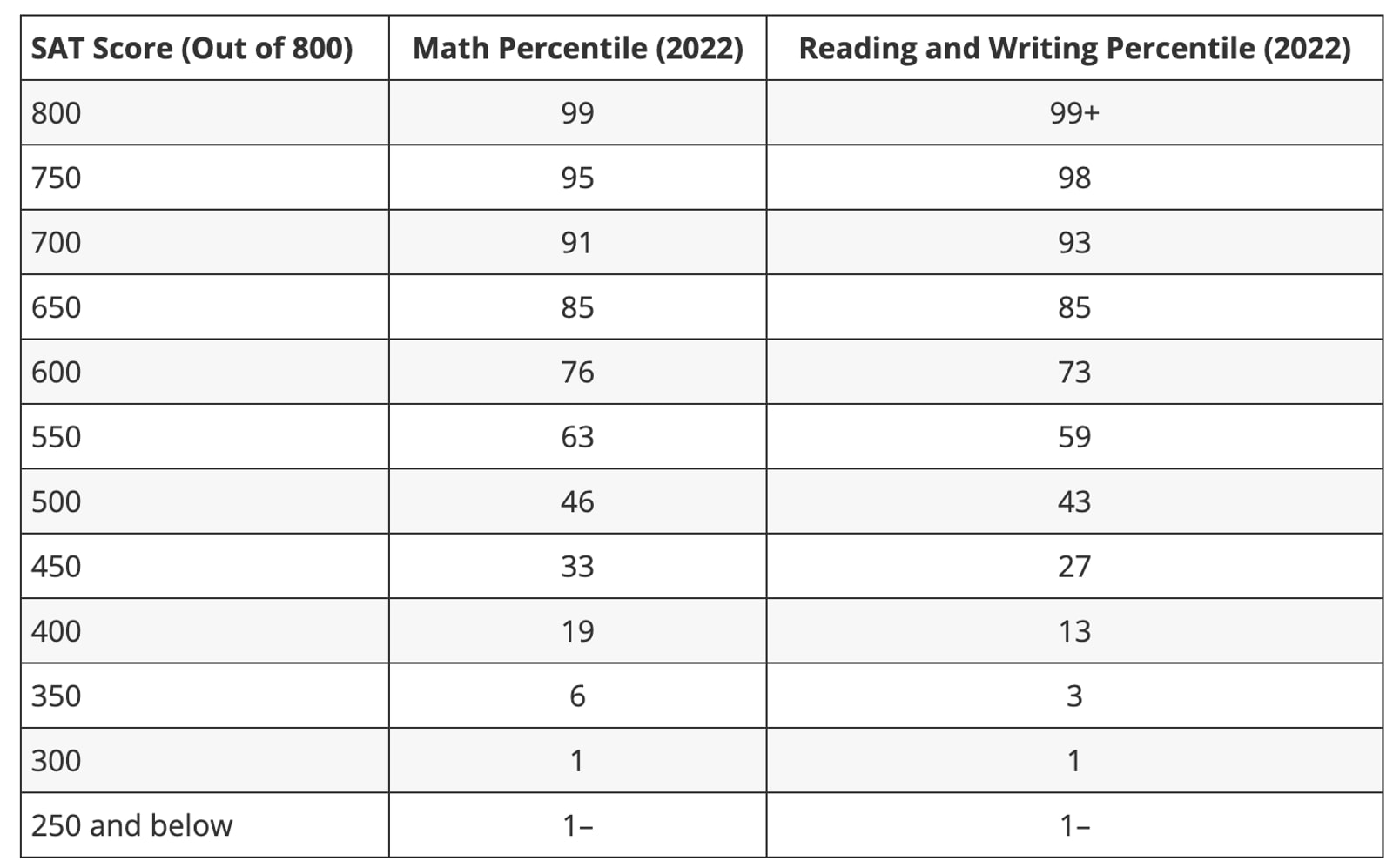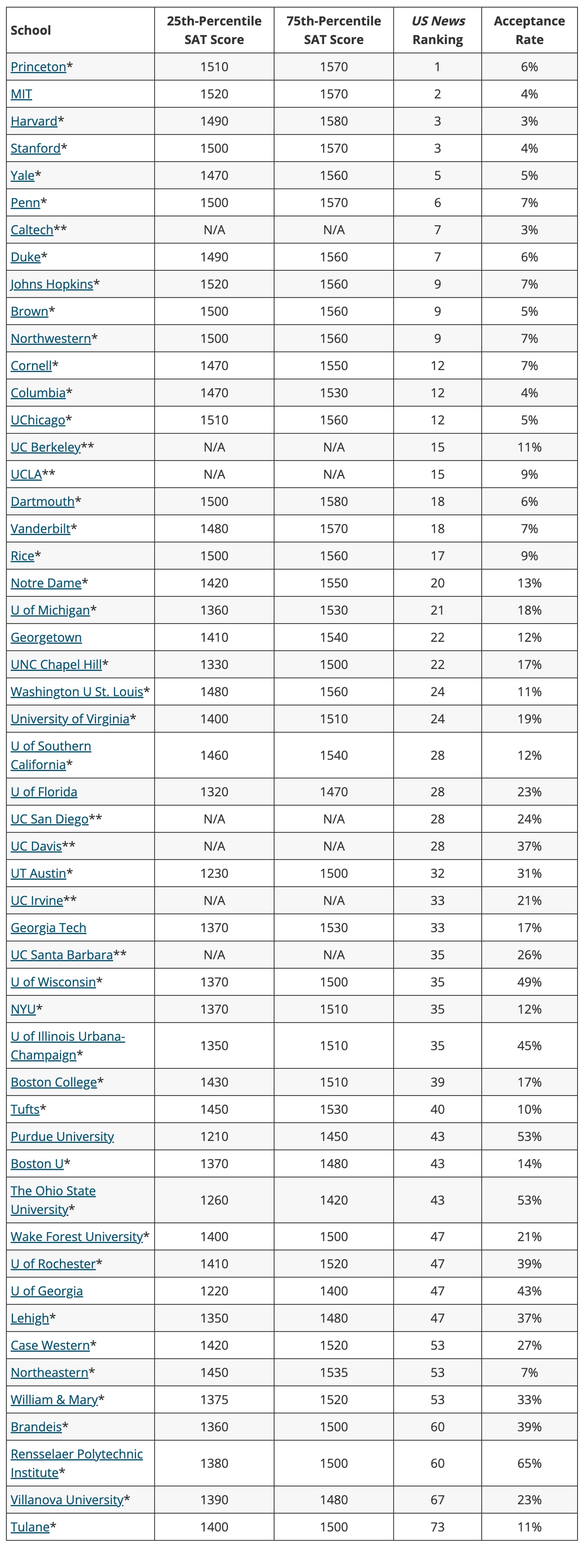How to Determine Your SAT Score Goal
Author
Hartwell
Date Published

What Is an Ideal SAT Score?
If you have just taken the SAT and received your score, you might be wondering how well you performed or what score you should aim for next time. This guide will help you assess your SAT score and understand how it ranks among all test-takers. Next, we will help you determine a suitable target score based on your desired colleges. Finally, we will provide SAT score ranges for over 50 popular universities and discuss what to do if your score falls short of expectations.
What Is Considered a "Good" SAT Score?
The SAT has a total score range of 400–1600, consisting of two sections: Math and Evidence-Based Reading and Writing (ERW), each with a maximum score of 800. Generally, the higher your score, the better you performed compared to other test-takers. But is there a specific score that defines a "good" result?
To evaluate your SAT performance, you need to understand the scoring mechanism. Your total SAT score (out of 1600) corresponds to a percentile ranking, indicating the percentage of test-takers you outperformed. For example, if you are in the 60th percentile, it means your score is higher than 60% of test-takers.
According to statistical data, the national average SAT score is around 1050, with an average of 521 in Math and 529 in ERW. Since SAT scores follow a normal distribution, most students' scores cluster around the middle range (approximately 1000), while extremely high or low scores are less common.
Below are some SAT composite score percentiles from 2022 to help you understand different score rankings:
1000 → 45th percentile (higher than 45% of test-takers)
1100 → 63rd percentile (higher than 63% of test-takers)
1250 → 81st percentile (top 19%)
1350 → 90th percentile (top 10%)
1400 → 93rd percentile (top 7%)
1500+ → Top 1%–2%
As the data shows, the higher your score, the smaller the percentile gain for every 100-point increase. For example, moving from 1000 to 1100 raises your ranking by nearly 18%, while improving from 1450 to 1550 only increases your ranking by about 3%.
How to Determine Whether Your SAT Score Is Ideal?
Generally, a score of 1050 is considered the national average, so anything above this can be viewed as "above average." A score of 1250 places you in the top 19%, which is considered strong. A 1350 puts you in the top 10%, while a 1400 secures a top 7% ranking. If your goal is an elite university, a score of 1500+ is typically required for strong competitiveness.
On the other hand, a score below 1050 is considered below average. For example, 950 corresponds to the 37th percentile (bottom one-third), while 900 places you in the 29th percentile (bottom one-fourth), making it less competitive.
Using this data, you can evaluate your SAT performance and set realistic goals for future improvement.
SAT Score Percentile Comparisons
The following comparison highlights the percentile distribution for SAT Math and ERW sections. While their distributions are similar, there are some subtle differences.
For example, high scores in ERW are relatively rarer than in Math. This can be seen in the data: a 750 in ERW corresponds to the 98th percentile (top 2%), whereas the same score in Math is only in the 95th percentile (top 5%). This suggests that achieving a high Math score is more common, while high ERW scores are rarer.

What SAT Score Is Right for You?
We have discussed how SAT scores relate to percentile rankings, but more importantly, does your score meet the admission standards of your target colleges?
For instance, a 1280 falls in the 84th percentile, meaning you outperformed 84% of test-takers. This is a solid score for schools like Arizona State University (average SAT: 1245) and Temple University (average SAT: 1245).
However, if your goal is to attend top-tier institutions like MIT, Princeton, Duke, the University of Chicago, or Johns Hopkins University, a 1280 would be insufficient, as these schools typically have much higher SAT admission thresholds.
Of course, not everyone aims for elite universities. For less selective schools, such as Indiana University Northwest (average SAT: 1050) or Texas A&M Business School (average SAT: 1050), a 1040 would be considered a relatively strong score.
By understanding your SAT score in relation to national percentiles and target college expectations, you can set appropriate goals and maximize your chances of admission to your desired schools.
Additional Benefits of a High SAT Score
A strong SAT score not only enhances your competitiveness but can also bring additional advantages, such as:
Scholarship Opportunities: Many universities offer scholarships to high-scoring students. The higher your score, the greater your chances of receiving financial aid.
Compensating for a Low GPA: If your GPA is below the average admission standard for certain schools, a high SAT score may improve your chances of acceptance. However, for top-tier institutions, a high SAT score alone is not enough—they prioritize well-rounded applicants.
SAT Score Standards for Major Universities
To help you set clear goals, we have compiled the SAT score ranges (25th and 75th percentiles) for over 50 popular universities in 2022. Additionally, we provide U.S. News rankings and acceptance rates to help you understand the level of competition at different schools. This data will assist you in determining an appropriate SAT target score and formulating an effective study plan.

What to Do If Your SAT Score Falls Short? Three Response Strategies
If your SAT score does not meet your target, how should you respond? Here are three main strategies to help you find the best solution for your situation.
Strategy 1: Retake the SAT
If time allows, retaking the SAT may be the best option for improving your score. However, achieving a significant score increase requires dedicated time and effort, with a focus on strengthening weaker areas. Below is an estimate of study time required for different score improvements:
0 to 30 points: ~10 hours
30 to 70 points: ~20 hours
70 to 130 points: ~40 hours
130 to 200 points: ~80 hours
200 to 330 points: 150+ hours
If you decide to retake the SAT, it is advisable to develop a structured study plan, use official practice materials, and concentrate on improving weaker sections.
Strategy 2: Don't Overthink It
If your score is within 50 points of your target but still competitive, you may not need to take additional action. For example, if your target score is 1560, but you scored 1530, you are still within the acceptable range for your desired college.
In such cases, rather than spending excessive time preparing for a retake, consider focusing on other aspects of your college application, such as improving your essays, participating in extracurricular activities, or securing strong letters of recommendation.
However, if your SAT score falls more than 50 points below your goal, you might want to consider Strategy 1 (Retake the SAT) or Strategy 3 (Adjust Your College List).
Strategy 3: Adjust Your College List
If your SAT score is more than 50 points below your expected target and you do not have time to retake the test, consider modifying your college application list. You can still apply to your dream schools, but it’s a good idea to add more institutions that match your current score to ensure better admission chances.
For example, suppose your target score was 1510, but you ended up with 1410:
Originally Matched Schools: New York University (SAT middle 50%: 1370-1510). Your score is now below the 75th percentile (1510), making admission more challenging.
Adjusted Matched Schools: Consider shifting Lehigh University (SAT middle 50%: 1300-1430) from a safety school to a match school, as it better aligns with your current score.
Adding New Safety Schools: Schools like American University (SAT middle 50%: 1220-1380) or Pennsylvania State University (SAT middle 50%: 1160-1370) could be included as additional options to ensure acceptance.
Conclusion: What Defines a "Good" SAT Score?
So, what exactly qualifies as a good SAT score?
Your SAT total score (out of 1600) corresponds to a percentile ranking, indicating where you stand among all test-takers. The national average SAT score is currently around 1050, but whether a score is "good" depends primarily on your target schools.
We have provided SAT score ranges for 50 popular universities to help you evaluate your target score. Additionally, we’ve outlined strategies for addressing lower-than-expected scores, including:
- Retaking the SAT to achieve a higher score.
- Not stressing over minor score differences if still competitive.
- Adjusting your college list to include more suitable options.
Ultimately, a "good" SAT score is relative—it should align with your target schools rather than being based on comparisons with others. Your goal is to achieve a score high enough to gain admission to your desired university, not just to outperform your peers!
Related Posts

Get all the details on the Digital SAT Test—adaptive testing, built-in tools, shorter format, and why it’s more student-friendly than ever!

Get a clear understanding of SAT scores with this detailed guide. Learn what each section measures, and how to interpret your results effectively.